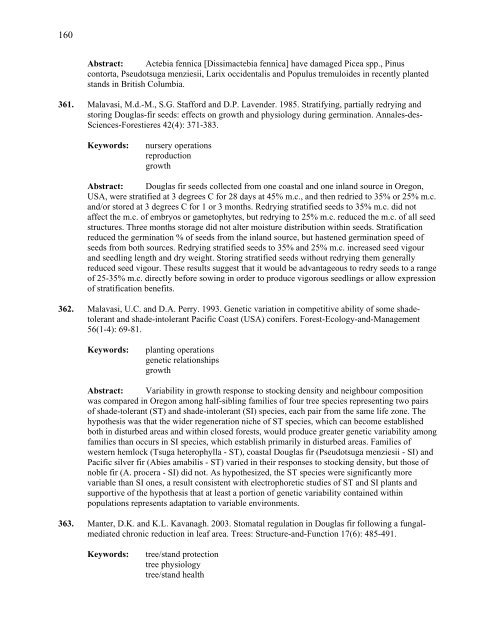IntensIve sIlvIculture - Forest Science Labs - Research Network ...
IntensIve sIlvIculture - Forest Science Labs - Research Network ...
IntensIve sIlvIculture - Forest Science Labs - Research Network ...
You also want an ePaper? Increase the reach of your titles
YUMPU automatically turns print PDFs into web optimized ePapers that Google loves.
160<br />
Abstract: Actebia fennica [Dissimactebia fennica] have damaged Picea spp., Pinus<br />
contorta, Pseudotsuga menziesii, Larix occidentalis and Populus tremuloides in recently planted<br />
stands in British Columbia.<br />
361. Malavasi, M.d.-M., S.G. Stafford and D.P. Lavender. 1985. Stratifying, partially redrying and<br />
storing Douglas-fir seeds: effects on growth and physiology during germination. Annales-des-<br />
<strong>Science</strong>s-<strong>Forest</strong>ieres 42(4): 371-383.<br />
Keywords: nursery operations<br />
reproduction<br />
growth<br />
Abstract: Douglas fir seeds collected from one coastal and one inland source in Oregon,<br />
USA, were stratified at 3 degrees C for 28 days at 45% m.c., and then redried to 35% or 25% m.c.<br />
and/or stored at 3 degrees C for 1 or 3 months. Redrying stratified seeds to 35% m.c. did not<br />
affect the m.c. of embryos or gametophytes, but redrying to 25% m.c. reduced the m.c. of all seed<br />
structures. Three months storage did not alter moisture distribution within seeds. Stratification<br />
reduced the germination % of seeds from the inland source, but hastened germination speed of<br />
seeds from both sources. Redrying stratified seeds to 35% and 25% m.c. increased seed vigour<br />
and seedling length and dry weight. Storing stratified seeds without redrying them generally<br />
reduced seed vigour. These results suggest that it would be advantageous to redry seeds to a range<br />
of 25-35% m.c. directly before sowing in order to produce vigorous seedlings or allow expression<br />
of stratification benefits.<br />
362. Malavasi, U.C. and D.A. Perry. 1993. Genetic variation in competitive ability of some shadetolerant<br />
and shade-intolerant Pacific Coast (USA) conifers. <strong>Forest</strong>-Ecology-and-Management<br />
56(1-4): 69-81.<br />
Keywords: planting operations<br />
genetic relationships<br />
growth<br />
Abstract: Variability in growth response to stocking density and neighbour composition<br />
was compared in Oregon among half-sibling families of four tree species representing two pairs<br />
of shade-tolerant (ST) and shade-intolerant (SI) species, each pair from the same life zone. The<br />
hypothesis was that the wider regeneration niche of ST species, which can become established<br />
both in disturbed areas and within closed forests, would produce greater genetic variability among<br />
families than occurs in SI species, which establish primarily in disturbed areas. Families of<br />
western hemlock (Tsuga heterophylla - ST), coastal Douglas fir (Pseudotsuga menziesii - SI) and<br />
Pacific silver fir (Abies amabilis - ST) varied in their responses to stocking density, but those of<br />
noble fir (A. procera - SI) did not. As hypothesized, the ST species were significantly more<br />
variable than SI ones, a result consistent with electrophoretic studies of ST and SI plants and<br />
supportive of the hypothesis that at least a portion of genetic variability contained within<br />
populations represents adaptation to variable environments.<br />
363. Manter, D.K. and K.L. Kavanagh. 2003. Stomatal regulation in Douglas fir following a fungalmediated<br />
chronic reduction in leaf area. Trees: Structure-and-Function 17(6): 485-491.<br />
Keywords: tree/stand protection<br />
tree physiology<br />
tree/stand health
















